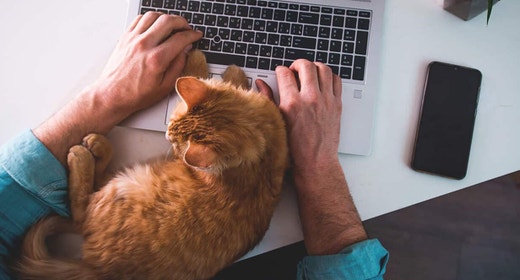

Cats don’t lack personality; that’s for sure. They can be shy, outgoing, snuggly, independent, energetic, relaxed and everything in between. Yet some breeds tend to exhibit certain traits more strongly than others. Here are our picks for what we’re calling the Cat Personality Awards.
This larger cat has a big heart to match. They’re often very social and happy to chat with you, whether they’re curled up on your lap or following you around the house. They make excellent family pets because more family members means more people to snuggle and play with.
Also outgoing: Ragdoll, Siamese, Burmese
Gentle and calm, this soft and silky-furred feline is friendly without being demanding. Ragdolls are usually totally cool sharing a house with other pets and kids. They don’t stress much about routine changes or even being carried around. Their motto? It’s all good.
Other cool kitties: Scottish fold, Birman, British shorthair
Making up around 90% of cats in the U.S., with more than 80 colors and patterns, domestic shorthairs are a melting pot of different breeds. They were originally working cats used to hunt mice and other critters on farms. They still love to stalk, hunt and pounce on toys and play games with their owners — so expect to spend lots of energetic playtime together.
Also ready to play: Siamese, Maine coon, Manx
This popular breed has been around humans since the 1600s, but is satisfied doing its own thing. Gentle, docile and quiet, Persian cats don’t insist on a lot of attention. They’re just as content sitting on your lap or observing what’s going on by themselves from a sunny perch across the room. They can be discerning in who they give their affection to, but you’ll be on their good side once you earn their trust.
Also fine on their own: Russian blue, American shorthair, Norwegian Forest cat
The idea of training a cat may seem hilarious, but the curiosity and intelligence of Abyssinians make them highly trainable. Some can even be taught tricks or to walk on a leash and harness. Training and playing games are perfect ways to direct their affectionate energy.
Also eager to learn: Bengal, Siamese, American shorthair
Owning this affectionate, hairless breed means you can spend more time cuddling and less time lint-rolling your clothes. They do require regular baths, but that just means more time to hang out together.
Other neat freaks: Siamese, Russian blue
Thinking of getting your first kitty? It’s hard to pick just one breed, so we’ve got three:
Remember, most cats — especially those found in shelters — are a mix of breeds, which just means they often combine the best of all cat personality traits! Whatever personality you’re looking for in a cat, you’ll know it when you find your fuzzy soulmate.


Fiber isn’t just for humans — it’s an important part of balanced nutrition for cats, too!
But how much fiber do cats need, what kinds should they be eating and how can you make sure they’re getting the right amount for their bodies?
Cats and humans both need fiber in their diets, but that doesn’t mean cats should be eating the same amount as humans. People are growing more aware of the importance of fiber in our own diets today — and while it’s good to think about your cat’s fiber intake too, it’s important to remember that cats have different dietary needs than humans.
Cats have a much shorter digestive tract than humans, and unlike humans, cats are carnivorous, so their nutritional needs are better satisfied with mostly animal-based ingredients rather than plant matter.
Nondigestible fiber supports cat health by providing bulk that helps move food through the digestive system. This fiber is largely made up of carbohydrates that cats can’t break down in the same way they digest protein or fat. This undigested matter helps usher food through your cat’s system at a healthy pace that lets them absorb the nutrients in their food and eliminate waste comfortably. Higher levels of nondigestible fiber can even help address specific conditions like frequent hairballs.
Fiber can’t be broken down and digested like proteins and fats, but some kinds can be fermented (broken down by bacteria) in your cat’s digestive system. This breakdown produces short-chain fatty acids, which provide energy to your cat’s intestines as it is fermented.
Fiber sources used in pet foods include cellulose, which is poorly fermentable; beet pulp, which is moderately fermentable; and gums and pectin, which can be highly fermentable. Appropriate levels of moderately fermentable fiber, such as beet pulp, provide the benefits of energy for the intestinal lining and bulk without the negative effects of excessive stool or gas. That makes them ideal for the health and comfort of most cats!
While a high-fiber diet can be part of a weight-loss solution for humans, our research has found that it’s not as helpful as a weight-reduction option for cats.
High levels of poorly fermentable fiber in cat food dilute the calories and nutrients in a serving and may make your cat feel fuller. Unfortunately, high fiber content can also increase the rate at which food passes through your cat’s digestive tract, making it harder for them to digest other nutrients in their food. They may be going to the litter box more often, but that doesn’t mean their digestive system is working more efficiently.
When choosing a pet food, remember that cats and humans need different things from their food. All IAMS™ cat food products are made with the right amount of moderately fermentable fiber needed to promote intestinal health. Use the IAMS™ Cat Food Selector to find a recipe tailored to your cat’s unique needs.